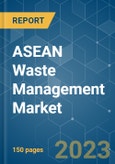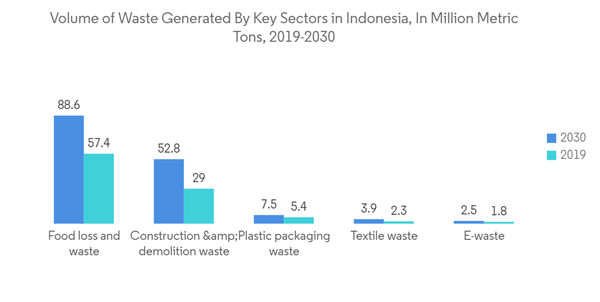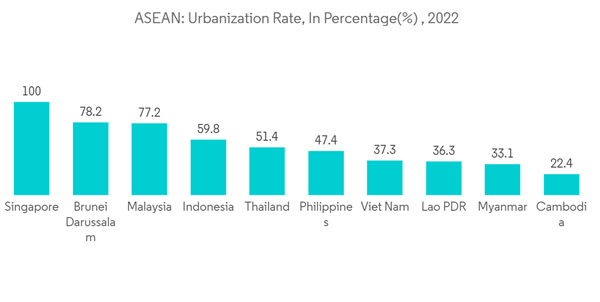Key Highlights
- In recent years, Malaysia, Vietnam, Thailand, and Indonesia have become the top destinations in Southeast Asia for the inflow of both legal and illegal waste from the US, Japan, the UK, the European Union (EU) and other countries. The sudden and sharp increase in waste imports has proved challenging for the countries in Southeast Asia, which have responded by returning containers of waste to the countries of origin, announcing bans on the import of some types of waste and tightening regulations and increasing enforcement. These measures resulted in a reduction in the amount of waste entering their countries.
- Despite current efforts, illegal waste continues to reach Southeast Asian countries. Uncontrolled and illicit waste flows are frequently hidden behind controlled or legal transboundary movements of goods - the boundaries between licit and illicit waste trafficking activities can be very thin, and the activities, actors, and modes of operation involved frequently overlap. The impact is magnified when destination countries lack enforcement capacity and/or adequate sanctions for illegal waste trade activities.
- With the increased waste generation in the region, open dumping and open burning of waste are highly prevalent in the majority of the ASEAN countries. Composting and anaerobic digestion of organic wastes, and recovery of valuable recyclables such as plastic, metal, and paper are quite common in ASEAN. Recycling, however, is more in the hands of the informal sector. Nevertheless, Singapore stands as an exception to other ASEAN countries, as it has a sound and well-structured waste management system in place. Singapore opts for waste to energy (WTE) through incineration as the major waste management option, due to its limited land resources.
- Southeast Asia's current production and consumption trajectory, as a result of its rapid growth, is increasingly putting a strain on the environment. Measures to contain the pandemic have exacerbated environmental pressures due to increased volumes of medical waste, plastics, and packaging as a result of the e-commerce boom, as well as other resource stresses. As the region's countries embark on their green recovery agenda in the aftermath of COVID-19, there is an urgent need to shift from the linear economic model of "take, make, waste" to a circular system. A circular economy is based on three principles: (i) reducing waste and pollution; (ii) reusing products and materials; and (iii) regenerating natural ecosystems.
- The region has created a framework that emphasises the importance of trade, technological innovation, and financial markets in accelerating circular transformation. The five strategic priorities outlined below will pave the way for a smooth transition to a circular economy. Standardization and mutual recognition of circular products and services.
- ASEAN countries must review existing arrangements in various sectors and harmonise standards in order to enable the trade of circular products and services and facilitate value chain integration. To mainstream and scale circularity, a widely accepted definition of circular products and services should be established through the development of a taxonomy, which can help businesses reduce compliance costs and unnecessary regulatory burdens.
ASEAN Waste Management Market Trends
Indonesia Advances Zero-Plastic Waste Ambitions with Public-Private Partnership to Build Waste Management Capacity and Capability
On June 20, 2022, the Indonesian government declared yet another significant step toward achieving trash management goals outlined in the nation's National Action Plan for Sea Debris Management and National Plastic Action Partnership. The Alliance to End Plastic Waste (Alliance), a worldwide non-profit organization, has joined with the Coordinating Ministry for Maritime and Investment Affairs (CMMAI), the Malang Regency, and other parties to create the Bersih Indonesia: Eliminasi Sampah Plastik initiative. One of the largest public-private waste management partnerships in the world, the initiative aims to improve the collection, sorting, and recycling of plastic trash in Indonesia. Moreover, it intends to show how a commercially viable plastic waste management strategy can be scaled up and applied across Indonesia and beyond.With a population of over 270 million and the largest economy in ASEAN, Indonesia is a vital actor in the effort to minimize plastic waste on a regional and global scale. It joined the Global Plastic Action Partnership in 2019 and launched the National Plastic Action Partnership as the first nation. By 2025, the amount of marine plastic waste leakage is to be reduced by 70%, and by 2040, there will be almost no plastic waste contamination. In order to meet these goals, waste management and recycling would need to receive around USD 18 billion in capital investments between 2017 and 2040. By that same year, solid waste management will also need an extra USD 1 billion in operating funding. Bersih Indonesia was created to improve collecting, sorting, processing, and recycling while also addressing funding issues on two fronts. To achieve this, it optimized operating expenses and improved revenue sources by combining regency-wide collection fees with increased material sales.
The project will be implemented in phases over three Javan regencies Malang, Magelang, and Sukabumi - serving a total of about 6.5 million people. When operating at full capacity, the three systems hope to divert roughly 140,000 tonnes of plastic garbage annually and collect over 800,000 tonnes of municipal solid waste together, with the potential to support up to 8,000 employment. The multi-year project has begun in Malang, East Java's second-largest regency. Phase One will be constructed at a cost of USD 29 million, which will be covered entirely by the Alliance, and is anticipated to serve more than 2.6 million people.
Changing the Tide on Plastic Waste in Southeast Asia through Regional Cooperation
Governments are measuring and monitoring plastics leakage on land, in rivers, and nearby oceans using cutting-edge techniques. The use of market-based tools and laws may be shown in globally successful instances. To enable customization, ASEAN nations are searching for direction and best practices. Plastics, which were heralded as a wonder material in the middle of the 20th century, today permeate every facet of everyday life worldwide. Yet, the rapid growth of plastic garbage presents serious risks to the environment, human health, and way of life, as well as related expenses. An estimated 11 million metric tons of plastic enter the ocean annually as of July 2022.In addition, if no immediate action is taken, this sum will quadruple in the next two decades. Southeast Asia has become a major source of plastic pollution due to its fast urbanization, growing middle class, and weak waste management infrastructure. Here are five of the top ten nations responsible for plastic leakage into rivers and oceans. Moreover, COVID-19 has been a plastic pandemic that has led to sharp rises in the use of single-use products including masks, sanitizing bottles, and packaging for internet deliveries. The cycle of take, make, and waste is typical of the plastics economy.
This indicates that between USD 80 billion (SD 112 billion) and USD 120 billion per year roughly 95% of the value of plastic packaging is lost to the economy due to waste. When single-use plastic is thrown rather than collected and recycled, approximately 75% of the material value of recyclable plastic is lost in Malaysia, the Philippines, and Thailand. This represents a loss of USD 6 billion annually.
There were 14 top priorities for member nations in the ASEAN Regional Action Plan. Also, the World Bank authorized a USD 20 million grant last month to help fund these initiatives, which include bolstering and harmonizing regional rules that control the manufacture and consumption of plastics.
ASEAN Waste Management Market Competitor Analysis
The ASEAN Waste Management Market is fairly fragmented in nature, and highly price competitive. The industry is highly fragmented due to the presence of numerous local and international rivals, such as Sembcorp, REDWAVE, Joraform AB, Shred-Tech Corp, Erdwich Zerkleinerungs-Systeme GmbH, Lindner-Recyclingtech GmbH, PT Prasadha Pamunah Limbah Industri, and PT Fajar Surya Wisesa Tbk. ASEAN nations need skilled waste management firms that abide by the law and effectively manage garbage issues, particularly the ocean plastic crisis.Additional Benefits:
- The market estimate (ME) sheet in Excel format
- 3 months of analyst support
Table of Contents
1 INTRODUCTION1.1 Scope of the Study
1.2 Key Deliverables of the Study
1.3 Study Assumptions
2 RESEARCH METHODOLOGY
2.1 Analysis Methodology
2.2 Research Phases
3 EXECUTIVE SUMMARY
4 MARKET OVERVIEW
4.1 Market Overview
4.2 Market Dynamics
4.2.1 Drivers
4.2.2 Restraints
4.2.3 Opportunities
4.3 Industry Attractiveness - Porter's Five Forces Analysis
4.4 Value Chain/Supply Chain Analysis
4.5 Insights on the Logisitcs support and development in the waste management industry in ASEAN
4.6 Insights on the strategies of the rising startups venturing into the ASEAN waste management industry
4.7 Technological advancement and innovation in the effective waste management
5 MARKET SEGMENTATION
5.1 By Waste type
5.1.1 Industrial waste
5.1.2 Municipal solid waste
5.1.3 E-waste
5.1.4 Other Waste types
5.2 By Disposal methods
5.2.1 Collection
5.2.2 Landfill
5.2.3 Others
5.3 By Geography
5.3.1 Indonesia
5.3.2 Thailand
5.3.3 Malaysia
5.3.4 Singapore
5.3.5 Rest of ASEAN
6 COMPETITIVE LANDSCAPE
6.1 Overview (Market Concentration and Major Players)
6.2 Company Profiles
6.2.1 Singapore Waste Management Industry
6.2.2 Sembcorp Environmental Management Pte. Ltd. (Singapore)
6.2.3 Veolia Environmental S.A
6.2.4 Colex Holdings Limited
6.2.5 REDWAVE
6.2.6 Joraform AB
6.2.7 Shred-Tech Corp.
6.2.8 Erdwich Zerkleinerungs-Systeme GmbH
6.2.9 Lindner-Recyclingtech GmbH
6.2.10 PT Prasadha Pamunah Limbah Industri
6.2.11 PT Fajar Surya Wisesa Tbk
6.2.12 ECO Industrial Environmental Engineering Pte Ltd
6.2.13 Envipure
6.2.14 CH E-Recycling
6.2.15 Recycling Partners Pte. Ltd.*
7 INVESTMENT ANALYSIS
8 FUTURE GROWTH PROSPECTS OF ASEAN WASTE MANAGEMENT INDUSTRY
9 APPENDIX
9.1 Statistics on the state-wise solid waste generation in urban areas
9.2 ASEAN Size of Population (Million)
9.3 ASEAN GDP (Constant 2005 prices, USD Billion)
9.4 ASEAN GDP (Current Prices, USD Billion)
9.5 ASEAN Inflation
9.6 ASEAN Consumer Price Index (Absolute)
9.7 ASEAN Exchange Rate
Companies Mentioned (Partial List)
A selection of companies mentioned in this report includes, but is not limited to:
- Singapore Waste Management Industry
- Sembcorp Environmental Management Pte. Ltd. (Singapore)
- Veolia Environmental S.A
- Colex Holdings Limited
- REDWAVE
- Joraform AB
- Shred-Tech Corp.
- Erdwich Zerkleinerungs-Systeme GmbH
- Lindner-Recyclingtech GmbH
- PT Prasadha Pamunah Limbah Industri
- PT Fajar Surya Wisesa Tbk
- ECO Industrial Environmental Engineering Pte Ltd
- Envipure
- CH E-Recycling
- Recycling Partners Pte. Ltd.










